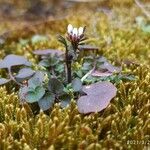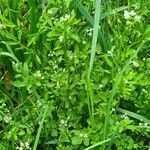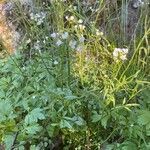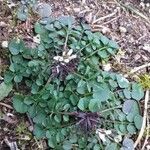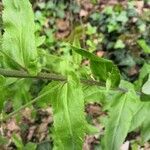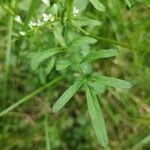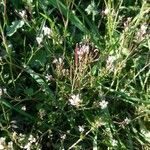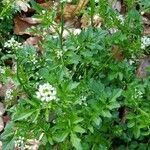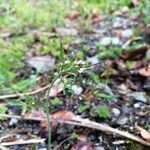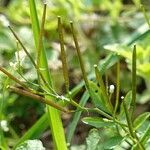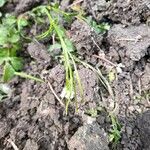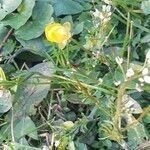Mostly perennial, diffusely branching herb; from the base usually many erect to ascending, curved or flexuous stems, in lower parts sometimes prostrate and rooting, 10-50 cm high with few to numerous scattered hairs. Basal leaves rarely persistent; cauline leaves nearly glabrous to sparsely pubescent, mostly numerous, imparipinnate with a terminal and 2 or 3 pairs of lateral leaflets, 2-10 cm long; petiole non-auriculate; leaflets narrowly to broadly ovate or orbicular in outline, obtuse, truncate to cuneate, usually crenate and often shallowly trifid; terminal leaflets 0.7-3.5 by 0.7-2 cm on distinct petiolules; lateral leaflets 0.4-1.5 by 0.3-1.5 cm on 1.5-7 mm long petiolules. Racemes terminal with 5-20 flowers, in fruit rather lax, up to 12 cm long; pedicels in fruit patent (angle to stem over 45°), 6-12 mm long with patent to erect siliquae, angled upwards at junction with the pedicel. Sepals green with narrow hyaline margins, oblong, obtuse, c. 1.5 mm long. Petals white, spathulate, 2.5-4 mm long. Stamens 6, distinctly tetradynamous; anthers 0.3-0.4 mm long. Ovary cylindrical with a rather short style, narrower than the ovary, and a flat stigma. Siliqua straight, linear, 18-30 by 0.8-1.2 mm; style 0.7-2 by c. 0.3 mm. Seeds reddish brown, often with a vestigial wing, broadly oblong in outline, 1.1-1.4 by 0.8-1.1 mm, nearly smooth.
Annual to perennial herb. Rhizomes 0. Stems erect, flexuous, hairy especially below, green, rarely purplish, (10)-15-30-(40) cm tall. Lvs thin, green, sparsely hairy above and sometimes beneath and on petiole. Rosette lvs pinnate, petiolate; terminal leaflet circular, bluntly lobed, cordate, slightly larger than laterals; lateral leaflets in (2)-3-4-(5) pairs, ovate, bluntly lobed, cordate and unequal at base; petiolules < leaflets. Cauline lvs pinnate, petiolate; terminal leaflet obovate, bluntly lobed, cuneate, becoming narrow-oblanceolate, toothed, slightly larger than the lateral leaflets; lateral leaflets in (2)-3-(4) pairs, ovate, cordate, becoming narrow-oblanceolate, toothed especially basiscopically, shortly petiolulate, becoming subsessile. Infl. racemose, flexuous, glabrous or sparsely hairy, (4)-6-10-(15) cm long. Pedicels glabrous or rarely the lowest sparsely hairy, erecto-patent to ± spreading, 3-10 mm long at fruiting. Sepals glabrous, purplish, pinkish or green, 1.3-1.7 × 0.5-0.8 mm; margins scarious. Petals white, ± erect, spathulate, 2-3 × 0.6-1.0 mm. Stamens 6. Silique pale greenish brown, rarely with purple valves, erecto-patent at angle to pedicel, (10)-15-18-(25) × c. 1 mm; valves glabrous; style 0.8-1 mm long. Seeds reddish brown, broad-oblong, very narrowly winged, c. 1 mm long.
Annuals or biennials; sparse-ly to densely hirsute basally or throughout, or glabrous. Rhizomes absent. Stems erect, ascending, or decumbent, branched or unbranched, (0.6-)1-5 dm, (slightly flexuous). Basal l eaves (often withered by anthesis), not rosulate, 5-15-foliolate, (2.7-)4-14 (-19) cm, leaflets petiolulate; petiole 0.7-5 cm, (ciliate or not); lateral leaflet blade oblong, ovate, or elliptic, smaller than terminal, margins entire, repand, crenate, or 3 (or 5)-lobed; terminal leaflet (petiolule 0.3-1.7 cm), blade reniform, broadly ovate, or suborbicular, 0.5-2.5 cm × 4-30 mm, margins repand, crenate, or 3 or 5-lobed. Cauline leaves 3-15, 5-15-foliolate [leaves (2-)3.5-5.5(-7) cm, including petiole], petiolate, leaflets petiolulate; petiole base not auriculate; lateral leaflets similar to basal, (0.4-2.5 mm wide). Racemes ebracteate. Fruiting pedicels divaricate or ascending, (5-)6-14(-17) mm. Flowers: sepals oblong, 1.5-2.5 × 0.7-1 mm, lateral pair not saccate basally; petals white, spatulate, 2.5-4(-5) × 1-1.7 mm; (stamens rarely 4, lateral pair absent); filaments 2-3 mm; anthers ovate, 0.3-0.5 mm. Fruits linear, (torulose), (0.8-)1.2-2.8 cm × 1-1.5 mm; ovules 18-40 per ovary; style 0.3-1(-1.5) mm. Seeds brown, oblong or subquadrate, 0.9-1.5 × 0.6-1 mm, (narrowly margined or not). 2n = 32.
Annual herb, rarely perennial in Australia, to 50 cm tall, erect, sparsely hirsute, the taproot not persistent. Basal leaves pinnate, petiolate, the pinnae 3–6 pairs narrowly ovate to reniform; cauline leaves reducing; pinnae sparsely hairy. Sepals c. 1.5 mm long, green-violet with narrow white margins. Petals 2.5–3 mm long, white. Stamens 6, rarely less. Style c. 1 mm long. Siliqua linear, 10–25 mm long, c. 1 mm wide, erect, often overtopping inflorescence. Pedicels erect to spreading, slender, curved, 5–13 mm long. Seeds ovoid, c. 1 mm long, compressed, narrowly winged.
Biennial, perennial or occasionally annual herb, up to 0.5 m high. Stems erect or decumbent, flexuous, hairy. Leaves with basal leaves in 2-7 pairs, pinnate; leaflets ovate to reniform, terminal leaflets larger; cauline leaves in 2-6 pairs, lateral leaflets narrowly ovate, margins dentate to entire. Flowers: petals 2.5-4.0 mm long, twice as long as sepals; white; Nov., Dec. Fruit with pedicels ascending or spreading; siliquae 12-25 x 1 mm.
A cabbage family herb. It grows each year from seeds. It grows up to 50 cm tall. It usually has several low branches. There are a ring of leaves at the base. The flowers are 3-4 mm across. The ripe pod is 1.2-2.5 cm long by 1-1.5 mm wide.
Leaves petiolate, pinnate with rounded reniform or obovate-cuneate leaflets up to about 10 x 8 mm. (in material from our area) usually lobed or toothed; cauline leaves sessile or shortly petiolate.
Annual or perennial herb, 10–50 cm. tall, with slender, branched stems, somewhat pubescent towards the base.
Sepals 1.5 x 0.5 mm., elliptic-oblong, greenish with a white margin.
Silique 10–25 x 0.7–1 mm., linear-oblong, glabrous.
Flowers white in terminal, subcorymbose racemes.
Seeds 2.5–1.5 mm., flattened-ellipsoid.
Stamens 6, filaments 0.5 mm. long.
Petals 1.5–2.5 x 0.7 mm., oblong.
Ovary 1 x 0.3 mm., cylindric.
